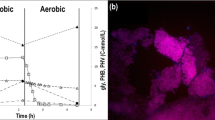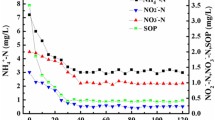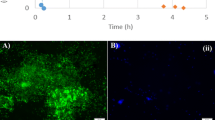Abstract
The use of saline water as secondary quality water in urban environments for sanitation is a promising alternative towards mitigating fresh water scarcity. However, this alternative will increase the salinity in the wastewater generated that may affect the biological wastewater treatment processes, such as biological phosphorus removal. In addition to the production of saline wastewater by the direct use of saline water in urban environments, saline wastewater is also generated by some industries. Intrusion of saline water into the sewers is another source of salinity entering the wastewater treatment plant. In this study, the short-term effects of salinity on the anaerobic metabolism of phosphate-accumulating organisms (PAO) and glycogen-accumulating organisms (GAO) were investigated to assess the impact of salinity on enhanced biological phosphorus removal. Hereto, PAO and GAO cultures enriched at a relatively low salinity level (0.02 % W/V) were exposed to salinity concentrations of up to 6 % (as NaCl) in anaerobic batch tests. It was demonstrated that both PAO and GAO are affected by higher salinity levels, with PAO being the more sensitive organisms to the increasing salinity. The maximum acetate uptake rate of PAO decreased by 71 % when the salinity increased from 0 to 1 %, while that of GAO decreased by 41 % for the same salinity increase. Regarding the stoichiometry of PAO, a decrease in the P-release/HAc uptake ratio accompanied with an increase in the glycogen consumption/HAc uptake ratio was observed for PAO when the salinity increased from 0 to 2 % salinity, indicating a metabolic shift from a poly-P-dependent to a glycogen-dependent metabolism. The anaerobic maintenance requirements of PAO and GAO increased as the salinity concentrations risen up to 4 % salinity.





Similar content being viewed by others
References
Acevedo B, Oehmen A, Carvalho G, Seco A, Borras L, Barat R (2012) Metabolic shift of polyphosphate-accumulating organisms with different levels of poly-phosphate storage. Water Res 46:1889–1900
Amann RI (1995) In situ identification of microorganisms by whole cell hybridization with rRNA-targeted nucleic acid probes. In: Akkermans ADL, van Elsas JD, de Bruijn FJ (eds) Molecular microbial ecology manual. Kluwer Academic Publisher, London, pp 1–15
APHA (1995) Standard Methods for the Examination of Water and Wastewater, 19th edn. American Public Health Association, Washington, DC
Brdjanovic D, van Loosdrecht MCM, Hooijmans CM, Alaerts GJ, Heijnen JJ (1997) Temperature effects on physiology of biological phosphorus removal. J Environ Eng-ASCE 123(2):144–154
Castle AM, Macnab RM, Shulman RG (1986) Coupling between the sodium and proton gradients in respiring escherichia coli cells measured by 23Na and 31P nuclear magnetic resonance. J Biol Chem 261(17):7797–7806
Crocetti GR, Hugenholtz P, Bond PL, Schuler A, Keller J, Jenkins D, Blackall LL (2000) Identification of polyphosphate-accumulating organisms and design of 16S rRNA-directed probes for their detection and quantitation. Appl Environ Microbiol 66:1175–1182
Crocetti GR, Banfield JF, Keller J, Bond PL, Blackall LL (2002) Glycogen accumulating organisms in laboratory-scale and full-scale wastewater treatment processes. Microbiol 148:3353–3364
Cui Y, Peng C, Peng Y, Ye L (2009) Effects of salt on microbial populations and treatment performance in purifying saline sewage using the MUCT process. Clean-Soil Air Water 37(8):649–656
Fahim FA, Fleita DH, Ibrahim AM, El-Dars FMS (2000) Evaluation of some methods for fish canning wastewater treatment. Water Air Soil Pollut 127:205–226
Filipe CDM, Daigger GT, Grady CPL (2001) A metabolic model for acetate uptake under anaerobic conditions by glycogen-accumulating organisms: stoichiometry, kinetics and effect of pH. Biotechnol Bioeng 76(1):17–31
Flowers JJ, He S, Yilmaz S, Noguera DR, McMahon KD (2009) Denitrification capabilities of two biological phosphorus removal sludges dominated by different ‘Candidatus Accumulibacter’ clades. Environ Microbiol Rep 1(6):583–588
Gonzalez JF, Civit EM, Lupin HM (1983) Composition of fish filleting wastewater. Water SA 9(2):49–56
Hong CC, Chan SK, Shim H (2007) Effect of chloride on biological nutrient removal from wastewater. J Appl Sci Environ Sanit 2(3):85–92
Intrasungkha N, Keller J, Blackall LL (1999) Biological nutrient removal efficiency in treatment of saline wastewater. Water Sci Technol 39(6):183–190
Kargi F, Uygur A (2005) Improved nutrient removal from saline wastewater in an SBR by Halobacter supplemented activated sludge. Environ Eng Sci 22(2):170–176
Lefebvre O, Moletta R (2006) Treatment of organic pollution in industrial saline wastewater: a literature review. Water Res 40:3671–3682
Leung RWK, Li DCH, Yu WK, Chui HK, Lee TO, Van Loosdrecht MCM, Chen GH (2012) Integration of seawater and grey water reuse to maximize alternative water resource for coastal areas: the case of the Hong Kong International Airport. Water Sci Technol 65(3):410–417
Liu WT, Mino T, Nakamura K, Matsuo T (1994) Role of glycogen in acetate uptake and polyhydroxyalkanoate synthesis in anaerobic-aerobic activated sludge with a minimized polyphosphate content. J Ferment Bioeng 77(5):535–540
Liu WT, Nakamura K, Matsuo T, Mino T (1997) Internal energy-based competition between poly-phosphate- and glycogen-accumulating bacteria in biological phosphorus removal reactors-effect of P/C feeding ratio. Water Res 31(6):1430–1438
Lopez C, Pons MN, Morgenroth E (2006) Endogenous processes during long-term starvation in activated sludge performing enhanced biological phosphorus removal. Water Res 40(8):1519–1530
Lopez-Vazquez CM, Song YI, Hooijmans CM, Brdjanovic D, Moussa MS, Gijzen HJ, van Loosdrecht MCM (2007) Short-term temperature effect on the anaerobic metabolism of glycogen accumulating organisms. Biotechnol Bioeng 97(3):483–495
Lu H, Keller J, Yuan Z (2007) Endogenous metabolism of Candidatus Accumulibacter phosphatis under various starvation conditions. Water Res 41(20):4646–4656
Mesple F, Troussellier M, Casellas C, Legendre P (1996) Evaluation of simple statistical criteria to qualify a simulation. Ecol Model 88(1–3):9–18
Orhon D, Tasli R, Sozen S (1999) Experimental basis of activated sludge treatment for industrial wastewaters—the state of the art. Water Sci Technol 40(1):1–11
Panswad T, Anan C (1999) Impact of high chloride wastewater on an anaerobic/anoxic/aerobic process with and without inoculation of chloride acclimated seeds. Water Res 33(5):1165–1172
Smolders GJF, Van der Meij J, Van Loosdrecht MCM, Heijnen JJ (1994a) Model of the anaerobic metabolism of the biological phosphorus removal process: stoichiometry and pH influence. Biotechnol Bioeng 43:461–470
Smolders GJF, van der Meij J, Van Loosdrecht MCM, Heijnen JJ (1994b) Stoichiometric model of the aerobic biological phosphorus removal process. Biotechnol Bioeng 44:837–848
Tang SL, Yue DPT, Li XZ (2006) Comparison of engineering costs of raw freshwater, reclaimed water and seawater for toilet flushing in Hong Kong. Water Environ J 20(4):240–247
Uygur A (2006) Specific nutrient removal rates in saline wastewater treatment using sequencing batch reactor. Process Biochem 41(1):61–66
Uygur A, Kargi F (2004) Salt inhibition on biological nutrient removal from saline wastewater in a sequencing batch reactor. Enzym Microb Technol 34:313–318
WSD (2009) Annual report 2008/2009. Water Supply Department, Hong Kong SAR Government
Wu G, Guan Y, Zhan X (2008) Effect of salinity on the activity, settling and microbial community of activated sludge in a sequencing batch reactors treating synthetic saline wastewater. Water Sci Technol 58(2):351–358
Zeng RJ, Yuan ZG, Van Loosdrecht MCM, Keller J (2002) Proposed modifications to metabolic model for glycogen-accumulating organisms under anaerobic conditions. Biotechnol Bioeng 80(3):277–279
Zeng RJ, van Loosdrecht MCM, Yuan Z, Keller J (2003) Metabolic model for glycogen-accumulating organisms in anaerobic/aerobic activated sludge systems. Biotechnol Bioeng 81(1):92–105
Zhou Y, Pijuan M, Zeng RJ, Lu H, Yuan Z (2008) Could polyphosphate-accumulating organisms (PAO) be glyccogen-accumulating organisms (GAO)? Water Res 42:2361–2368
Acknowledgments
This research study was carried out as part of the SALINE project (http://www.salinesanitation.info) led by UNESCO-IHE Institute for Water Education and consortium partners KWR Watercycle Research Institute, Delft University of Technology, University of Cape Town, The Hong Kong University of Science and Technology, The Higher Polytechnic Institute “José Antonio Echeverría,” and Birzeit University. The SALINE project is financed by UNESCO-IHE internal research fund with a special generous contribution from Professor George Ekama from University of Cape Town, to whom the authors would like to gratefully thank. Special thanks to UNESCO-IHE laboratory staff, in particular to Don van Galen, for all their support during the research project.
Author information
Authors and Affiliations
Corresponding author
Electronic supplementary material
Below is the link to the electronic supplementary material.
ESM 1
(PDF 60 kb)
Rights and permissions
About this article
Cite this article
Welles, L., Lopez-Vazquez, C.M., Hooijmans, C.M. et al. Impact of salinity on the anaerobic metabolism of phosphate-accumulating organisms (PAO) and glycogen-accumulating organisms (GAO). Appl Microbiol Biotechnol 98, 7609–7622 (2014). https://doi.org/10.1007/s00253-014-5778-4
Received:
Revised:
Accepted:
Published:
Issue Date:
DOI: https://doi.org/10.1007/s00253-014-5778-4




